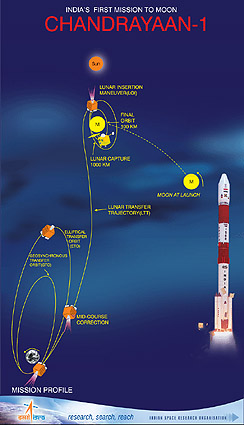Difference between revisions of "May 8, 2004"
| Line 1: | Line 1: | ||
__NOTOC__ | __NOTOC__ | ||
=Chandrayaan-1= | =Chandrayaan-1= | ||
| − | + | <p align="center"> | |
| − | + | <table width="640" border="0" align="center" cellpadding="6" cellspacing="2"> | |
| − | + | <tr> | |
| − | + | </tr></table> | |
| − | |||
| − | |||
| − | |||
<table border="0" align="center" cellpadding="6" cellspacing="2"> | <table border="0" align="center" cellpadding="6" cellspacing="2"> | ||
| − | + | <tr> | |
| − | + | <td><div align="center">[LPOD-2004-05-08b.htm [[File:LPOD-2004-05-08.jpeg|LPOD-2004-05-08.jpeg]]]</div></td> | |
| − | + | </tr> | |
| − | + | <tr> | |
| − | + | <td colspan="2"><div align="center"> | |
| − | + | <p class="main_sm">Image Credit: [http://www.isro.org/ Indian Space Research Organization]</p> | |
| − | + | </div></td> | |
| − | + | </tr> | |
| − | + | <table class="story" border="0" bgcolor="#FFFFFF" width="90%" cellpadding="10" align="center"> | |
| − | + | <tr> | |
| − | + | <td><p class="Story" align="center"><b><span class="class">Chandrayaan-1</span></b></p> | |
| − | + | <p class="story" align="left">With the excitement of the [http://www.lpod.org/archive/2004/04/LPOD-2004-04-28.htm US's plan] to return to the Moon it is easy to overlook the fact that American satellites won't be the only ones there. Indeed, there may be other humans on the Moon by the time American astronauts return. The most familiar players are the European Space Agency with its innovative but slow SMART-1 which is enroute to the Moon, Japan with its Lunar-A orbiter, and China, whose Chang'e program of orbiters, landers and sample return missions should begin in 2007. Less well known, but technologically very capable, is Indian's program of lunar exploration. The Indian Space Research Organization plans to launch Chandrayaan-1 to the Moon in 2007/8. This sophisticated orbiter will include high resolution (5 m) multi-spectral imaging, laser topographic mapping and X-ray spectrometer mapping of elements. India builds upon its extensive and successful experience in remote sensing of the Earth and will use its own launch vehicles. The next 1-5 years will see a windfall of new data about the Moon! Click image for more legible view.</p> | |
| − | + | <p class="story"><b>Related Links:</b><br> | |
| − | + | [http://www.isro.org/chandrayaan-1/announcement.htm Chandrayaan-1] <br> | |
| − | + | [http://www.chinadaily.com.cn/english/doc/2004-02/16/content_306324.htm Chinese Lunar Program ]<br> | |
| − | + | [http://cnews.canoe.ca/CNEWS/Science/2004/03/31/403498-ap.html Japanese Lunar Program] <br> | |
| − | + | [http://cnews.canoe.ca/CNEWS/Science/2004/03/31/403498-ap.html European Lunar Program]</p> | |
| − | + | <p class="story"><b>Tomorrow's LPOD:</b> The Crater Formerly Known As Prinz</p> | |
| − | + | </tr> | |
| − | + | </table> | |
| − | + | <hr> | |
| − | + | <p align="center" class="main_titles"><b>Author & Editor:</b><br> | |
| − | + | [mailto:tychocrater@yahoo.com Charles A. Wood]</p> | |
| − | + | <p align="center" class="main_titles"><b>Technical Consultant:</b><br> | |
| − | + | [mailto:anthony@perseus.gr Anthony Ayiomamitis]</p> | |
| − | + | <p align="center" class="main_titles"><b>A service of:</b><br> | |
| − | + | [http://www.observingthesky.org/ ObservingTheSky.Org]</p> | |
| − | + | <p align="center" class="main_titles"><b>Visit these other PODs:</b> <br> | |
| − | + | [http://antwrp.gsfc.nasa.gov/apod/astropix.html Astronomy] | [http://www.msss.com/ Mars] | [http://epod.usra.edu/ Earth]</p> | |
| − | |||
| − | |||
| − | |||
| − | |||
<p> </p> | <p> </p> | ||
| − | |||
| − | |||
---- | ---- | ||
===COMMENTS?=== | ===COMMENTS?=== | ||
Click on this icon [[image:PostIcon.jpg]] at the upper right to post a comment. | Click on this icon [[image:PostIcon.jpg]] at the upper right to post a comment. | ||
Revision as of 18:20, 4 January 2015
Chandrayaan-1
Image Credit: Indian Space Research Organization |
|
Chandrayaan-1 With the excitement of the US's plan to return to the Moon it is easy to overlook the fact that American satellites won't be the only ones there. Indeed, there may be other humans on the Moon by the time American astronauts return. The most familiar players are the European Space Agency with its innovative but slow SMART-1 which is enroute to the Moon, Japan with its Lunar-A orbiter, and China, whose Chang'e program of orbiters, landers and sample return missions should begin in 2007. Less well known, but technologically very capable, is Indian's program of lunar exploration. The Indian Space Research Organization plans to launch Chandrayaan-1 to the Moon in 2007/8. This sophisticated orbiter will include high resolution (5 m) multi-spectral imaging, laser topographic mapping and X-ray spectrometer mapping of elements. India builds upon its extensive and successful experience in remote sensing of the Earth and will use its own launch vehicles. The next 1-5 years will see a windfall of new data about the Moon! Click image for more legible view. Related Links: Tomorrow's LPOD: The Crater Formerly Known As Prinz |
Author & Editor:
Charles A. Wood
Technical Consultant:
Anthony Ayiomamitis
A service of:
ObservingTheSky.Org
Visit these other PODs:
Astronomy | Mars | Earth
COMMENTS?
Click on this icon File:PostIcon.jpg at the upper right to post a comment.




